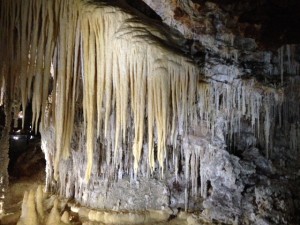France appears to be a world-leader in caves.
It has world-famous caves (Lascaux, and the Paleolithic paintings), it has deep caves, it has gigantic caves, it has long caves. It has lists of caves that do not appear to be remotely complete.
It has so many caves that some of them close to population centers appear not to be included on the above list.
One of them, the Grotte de Clamouse, is barely 30 minutes from where we are staying, in the Languedoc, but is well worth seeing. Particularly if you come from places where holes in the ground are usually dug, not scoured out by nature … and you have a couple of young visitors with you.
On the list of “things to do” in the Languedoc region is the Clamouse cave system.
It is just a few miles from a fairly well-known and especially scenic (now tending towards kitschy) medieval town of Saint-Guilhem-de-Desert, formerly recognized as being a stop on the southern French pilgrimage route to Santiago de Compostela, on the west coast of Spain.
Forming a sort of tourist troika, with the caves and the town is the Pont du Diable, one of the oldest medieval bridges in France, just down river from the caves and the town.
Back to the caves. These were created by the nearby Herault River, which now flows through the area in a deep gorge.
Originally, the river coursed through higher up in the gorge, and it was during this period that water ate away at the soft rock of the western hills, and then created stalagmites and stalactites, as well as numerous chambers for viewing the whole of the cave-creation process.
The cave is softly lit by the organizers of the tour, which sets off at the bottom of every hour. The tour is conducted in French but English-language listening devices are distributed for the price of the ticket — 10 euros per person.
It is a bit strenuous, which is not well-advertised. The 70-80-minute tour is about six-10ths of a mile in length, but much of it is a steady climb up the hillside — from the inside, of course.
The interesting bits are the fantastic shapes created by dripping water suffused with calcite and aragonite. A drip here, a drop there, and tens of thousands of years later you’ve got yourself a big, fat stalagmite.
Oh, and the cave also is home to several blind creatures (no need for sight when you live in total darkness), including a small fish and a sort of salamander-like creature, each of which is on display in an aquarium.
To get a sense of what the tour is like, starting with the view from above and continuing to the caves, have a look at this video that does a good job — though if obviously cannot pass on a sense of how moist it is, in the dripping caves, and how dependably cool — about 60 degrees Fahrenheit, all year round.
Key to the existence of the many French caves — beyond the French interest in them — is the existence of lots of old rock formations in the east and south of the country.
Stick a spade in the ground in some of these places, and you might find enormous networks of caves below your feet.
And the name of the caves? The French guide would have us believe that the name “Clamouse” is meant to describe the wailing of a mother whose over-inquisitive son drowned in the river inside the caves before his body washed up on the surface.


0 responses so far ↓
There are no comments yet...Kick things off by filling out the form below.
Leave a Comment